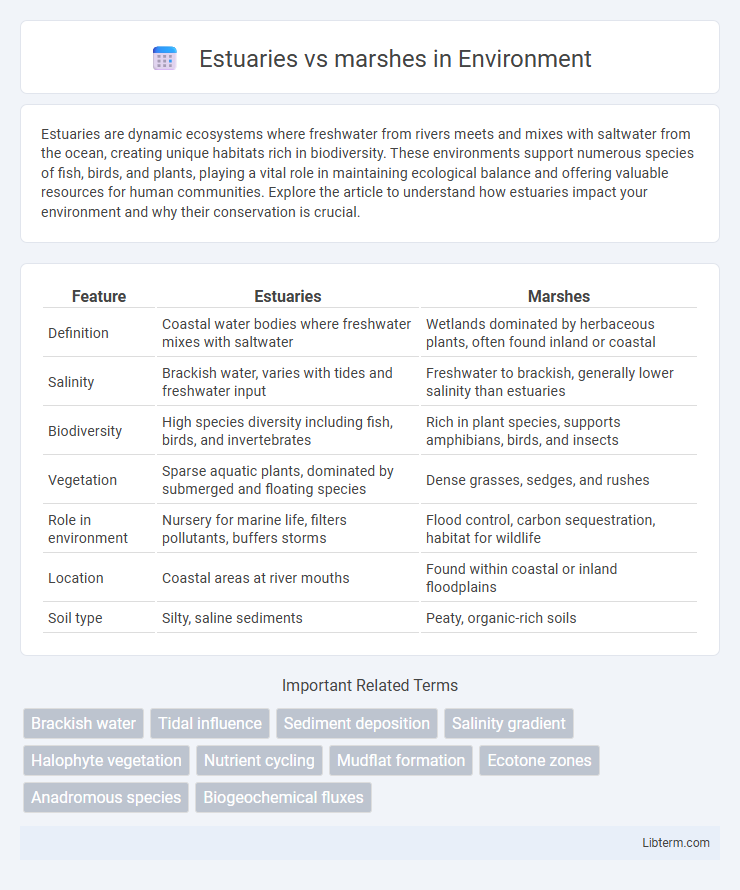Estuaries are dynamic ecosystems where freshwater from rivers meets and mixes with saltwater from the ocean, creating unique habitats rich in biodiversity. These environments support numerous species of fish, birds, and plants, playing a vital role in maintaining ecological balance and offering valuable resources for human communities. Explore the article to understand how estuaries impact your environment and why their conservation is crucial.
Table of Comparison
| Feature | Estuaries | Marshes |
|---|---|---|
| Definition | Coastal water bodies where freshwater mixes with saltwater | Wetlands dominated by herbaceous plants, often found inland or coastal |
| Salinity | Brackish water, varies with tides and freshwater input | Freshwater to brackish, generally lower salinity than estuaries |
| Biodiversity | High species diversity including fish, birds, and invertebrates | Rich in plant species, supports amphibians, birds, and insects |
| Vegetation | Sparse aquatic plants, dominated by submerged and floating species | Dense grasses, sedges, and rushes |
| Role in environment | Nursery for marine life, filters pollutants, buffers storms | Flood control, carbon sequestration, habitat for wildlife |
| Location | Coastal areas at river mouths | Found within coastal or inland floodplains |
| Soil type | Silty, saline sediments | Peaty, organic-rich soils |
Definition of Estuaries
Estuaries are coastal water bodies where freshwater from rivers and streams mixes with saltwater from the ocean, creating a unique brackish environment essential for diverse ecosystems. These dynamic zones support high biological productivity, serving as crucial nurseries for many fish species and providing habitat for migratory birds. Unlike marshes, which are wetlands dominated by herbaceous plants, estuaries function as transitional areas that regulate nutrient flow and filter pollutants before water reaches the ocean.
Definition of Marshes
Marshes are wetlands dominated by herbaceous plants such as grasses, reeds, and sedges, typically found in low-lying areas where freshwater or saltwater saturates the soil. These ecosystems provide critical habitat for diverse wildlife, support water filtration, and act as natural buffers against flooding. Unlike estuaries, which are coastal water bodies where freshwater mixes with seawater, marshes are primarily plant-based wetlands with stagnant or slow-moving water.
Key Differences Between Estuaries and Marshes
Estuaries are coastal water bodies where freshwater from rivers mixes with saltwater from the ocean, creating brackish water environments, while marshes are wetlands characterized by herbaceous plants and can be freshwater, brackish, or saltwater. Estuaries typically have open water channels and fluctuate with tides, supporting diverse aquatic species, whereas marshes have saturated soils with dense vegetation and serve as critical habitats for birds and amphibians. The key differences lie in their hydrology, salinity gradients, and dominant flora, with estuaries functioning as nutrient-rich transition zones and marshes providing essential flood control and water filtration.
Geographic Locations of Estuaries
Estuaries are commonly found along coastlines where freshwater rivers meet the ocean, such as the Chesapeake Bay on the U.S. East Coast, the Amazon River delta in South America, and the Thames Estuary in Europe. These areas are characterized by brackish water, influenced by tidal fluctuations and salinity gradients. In contrast, marshes are typically inland wetlands located in low-lying areas, often adjacent to estuaries or rivers, and dominated by herbaceous vegetation rather than saline conditions.
Geographic Locations of Marshes
Marshes are commonly found along coastal regions such as the Gulf Coast of the United States, the Baltic Sea in Northern Europe, and the extensive wetlands of the Mississippi River Delta. These freshwater or saltwater marshes often develop in low-lying areas where slow-moving or stagnant water allows the growth of herbaceous plants like cattails and reeds. Unlike estuaries, which are tidal water bodies mixing fresh and saltwater, marshes serve as critical habitats for diverse bird species and act as natural buffers against flooding and erosion.
Ecological Importance of Estuaries
Estuaries serve as critical habitats where freshwater from rivers meets and mixes with saltwater from the ocean, creating unique brackish environments that support diverse plant and animal species. They act as nurseries for many marine organisms, providing shelter and abundant nutrients necessary for the early development of fish, crustaceans, and birds. Their ability to filter pollutants and buffer against storm surges also makes estuaries vital for maintaining water quality and protecting coastal ecosystems.
Ecological Importance of Marshes
Marshes serve as critical habitats for diverse wildlife, acting as breeding grounds and nurseries for fish, birds, and amphibians while supporting complex food webs. Their dense vegetation helps filter pollutants, improve water quality, and reduce sediment load entering estuaries and coastal waters. Marshes also play a vital role in carbon sequestration and act as natural buffers against storm surges and coastal erosion.
Biodiversity in Estuaries vs Marshes
Estuaries support high biodiversity by providing nutrient-rich, brackish waters that serve as critical nurseries for many fish species and habitats for migratory birds. Marshes, characterized by freshwater or saltwater wetlands with dense vegetation, sustain diverse plant and animal life adapted to fluctuating water levels and salinity. Both ecosystems are vital for maintaining ecological balance, but estuaries often exhibit greater species diversity due to their unique mix of marine and freshwater influences.
Human Impact on Estuaries and Marshes
Human activities such as urban development, agriculture, and industrial pollution significantly degrade estuaries and marshes by introducing contaminants, altering water flow, and causing habitat loss. Nutrient runoff from fertilizers leads to eutrophication, creating hypoxic conditions that threaten aquatic species and disrupt ecosystem balance. Conservation efforts targeting pollution control and habitat restoration are essential to preserve the ecological functions and biodiversity of these vital coastal environments.
Conservation Strategies for Estuaries and Marshes
Effective conservation strategies for estuaries and marshes prioritize habitat restoration, pollution control, and sustainable land use management to preserve biodiversity and ecosystem services. Estuaries benefit from measures such as maintaining freshwater inflows, reducing nutrient runoff, and protecting critical nesting and spawning grounds for aquatic species. Marsh conservation emphasizes invasive species management, hydrological restoration, and the implementation of buffer zones to enhance resilience against climate change and sea-level rise.
Estuaries Infographic

 libterm.com
libterm.com